A leaking water softener can be a worrying sight. But thankfully, it’s not usually a cause for panic.
In this guide, I’ll talk you through how to diagnose a water softener that’s leaking. By the end, you should be confident that you know what the issue is, and how to fix it.
Some of the problems mentioned in this post have simple, quick-fix solutions that you can do yourself. Others, however, may require a professional plumber for the job.
Table of Contents
❗️ Preparing to Diagnose Leaking Water Softener
You might want to jump straight into diagnosing your leaking issue, and I get that.
But safety comes first, so before you start undoing things and sticking your hands into tight spaces, you need to make sure you won’t hurt yourself in the process.
First off, disconnect the system from its power outlet. Depending on the severity of the leak, it may be safer to do this at the circuit breaker.
Next, bypass the water supply by moving the bypass valve in the opposite direction. Instructions for your own water softener may vary, so check your user manual for more information if you’re unsure.
Once you’ve done this, you’ll no longer have the disruption of water to deal with while you’re working on your softener. Your home’s appliances will still have access to water – it just won’t be soft.
If your water softener doesn’t come with a bypass valve, either use the control head to set it in bypass mode or shut off the valve on your water supply line. You can now safely begin your diagnosis.
Related: Top rated smart water leak detectors in 2024
⬆️ Why Is My Water Softener Leaking From the Top?
Rotor Valve Cracked
The most common cause of a water softener leaking from the top is a cracked rotor valve. The rotor valve provides the water softener with water. After several years of operation, this valve can eventually degrade and crack, causing a leak.
The rotor valve itself might not be a problem, but it has a seal inside that may have become damaged. In that case, you will need to replace the seal.
Rotor valves are available online and cost around $50-$70 for a full kit, including the seal. Contact the manufacturer if you don’t know which parts will fit your water softener, or arrange for a plumber to do the job for you.
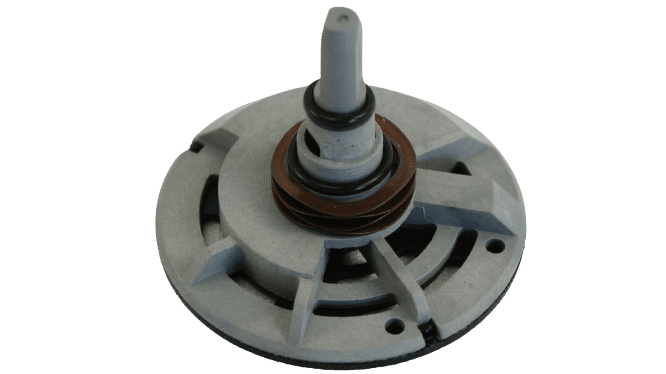
Bypass Valve O-rings Worn Out
Another likely issue that can result in your water softener leaking from the top is bypass o-rings that are past their best.
One of the regular water softener maintenance jobs is to lubricate your system’s o-rings when required. But eventually, usually after many years of use, the o-rings will become so worn that they need replacing altogether.
If you’ve not been properly lubricating your o-rings, they could become worn even before this time.
Again, replacing your bypass valve o-rings might be something that you can do yourself. But you’ll need to make sure you replace your o-rings with the right-sized parts to fit the system. You can contact a professional with plenty of water softener know-how if you need a little guidance.
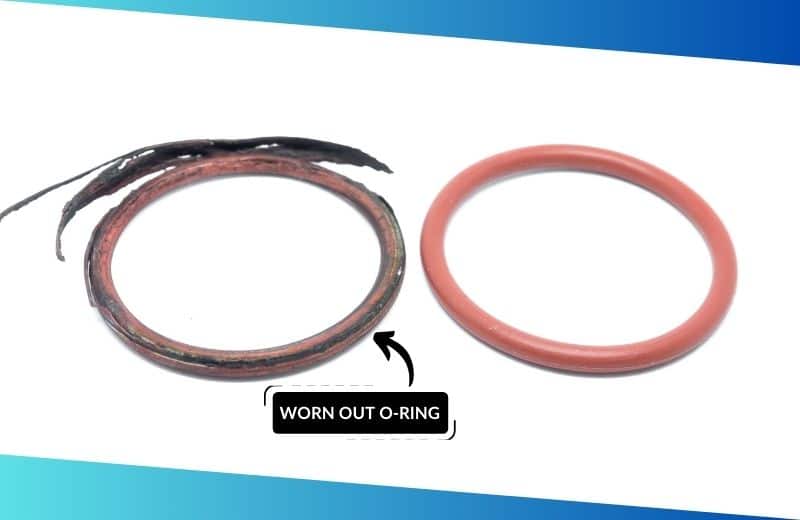
Overflow Issue
If you notice water flowing out of your brine tank, you may be dealing with an overflow issue. The tank float valve should prevent water from overfilling by telling it where to fill to.
It’s possible that your float valve might have become faulty or misaligned. Re-attach the float valve or replace it if necessary.
You should also check your lines and valves to make sure they’re not blocked, as this may also cause your water level to rise in the brine tank.
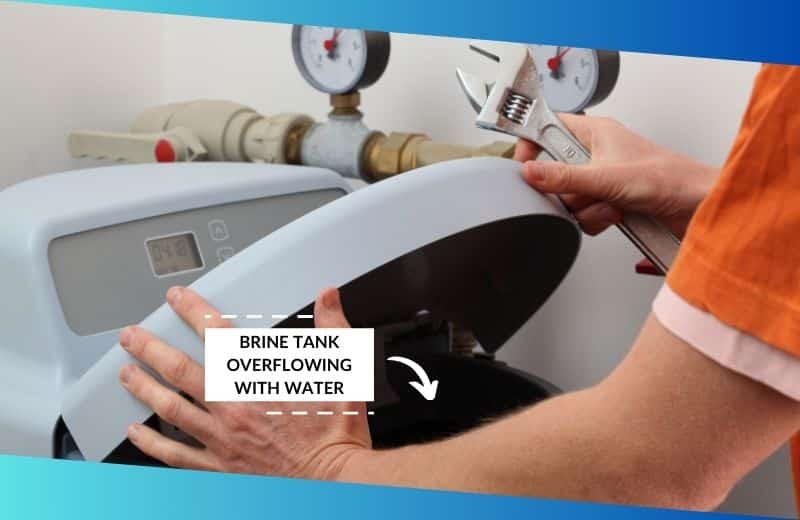
⬇️ Why Is My Water Softener Leaking From the Bottom?
Punctured Brine Tank
A water softener leaking from the bottom is most likely caused by a cracked or punctured brine tank. Unfortunately, this may have been an issue caused by yourself as you were clearing a salt bridge.
Many people don’t realize how delicate brine tanks are. It can be tempting to hack at a salt bridge with all your strength, but you may end up knocking a hole right through the tank if you use too much aggression.
There may be a few temporary fixes for a leaking tank, but ultimately, the entire tank will need to be replaced at some point if you want to avoid additional damage to the system.
If you’ve only just installed your water softener and you’ve noticed a leak from the bottom, it might be possible that you’ve received a faulty product.
Check your manufacturer’s warranty to see whether you’re eligible for a replacement part. It’s worth calling the manufacturer and explaining the situation anyway – they may offer you a free or discounted tank simply for being a loyal customer.
Cracked Resin Tank
A resin tank can also become cracked, and this is more likely to happen as the system ages, rather than as a result of your actions. Older resin tanks may rupture, allowing water to flow out of the crack or hole and onto the floor.
First thing’s first, empty the tank and clean it out thoroughly. You’ll then be able to pinpoint exactly where the leak (or leaks) is, and determine whether it’s small enough to repair.
If so, you’ll need to purchase epoxy that’s suitable for the job, and make sure you’ve properly prepped the areas before applying the epoxy to the surface.
Water softener resin tanks can cost upwards of $500 to replace, so if you’ve owned your system for longer than 10 years, it’s worth considering whether the better alternative is simply to buy an entirely new softening unit – see this post for the top systems available in 2024.
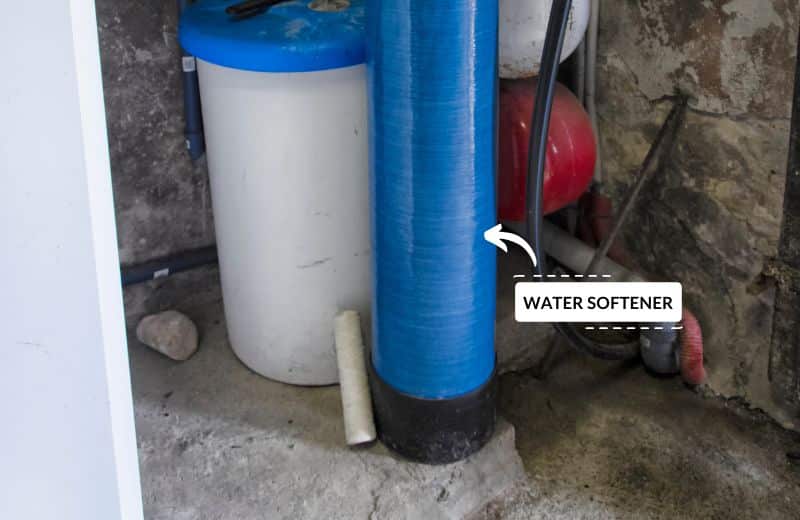
➰ What Causes a Water Softener Hose to Leak?
To determine whether the leak is coming from your water softener hose, check the connection between the hose and the top of the system.
Resolving this problem may be as easy as tightening the connection on a hose that has come loose. But if your hose has worn down over years of use, it may be too far gone to repair yourself.
Call a professional plumber to take a look at the issue. They may be able to repair it, or they might recommend that you replace the whole thing.
Replacing your water softener’s hose is one of the simplest jobs, and you should be able to do it yourself. Just remember to disconnect your unit from water and electricity supplies before getting started.
〰️ Why Is My Drain Line Leaking?
A water softener leaking from the drain line may be caused by a fault in the plumbing. To find the drain line, check the area above the unit. It will be easy to spot if water is leaking from this component.
You may be able to replace the drain line yourself – but it’s worth calling your manufacturer if you don’t know which part will fit your system. Of course, a professional plumber is guaranteed to solve the issue quickly and expertly, if you’d rather not do it yourself.
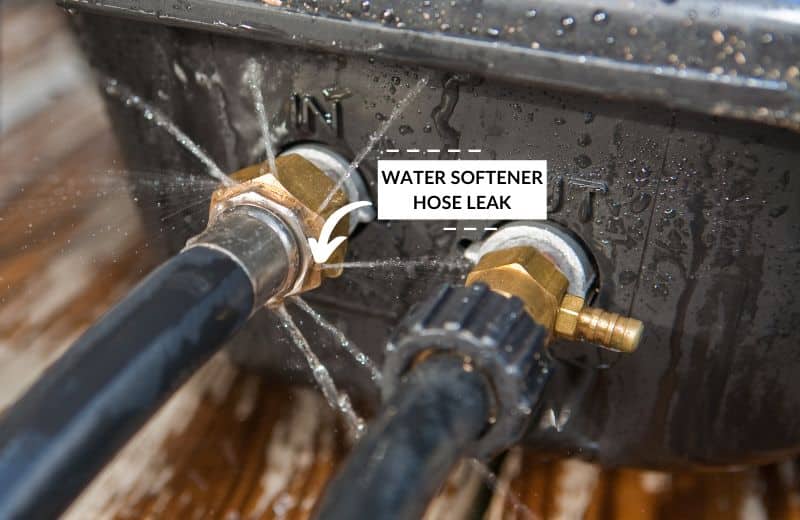
🔧 How Should I Fix a Leaking Water Softener?
With a water softener leaking issue, you’ll need to resolve the problem as quickly as possible to prevent damage to the unit and your home.
In the meantime, set water to bypass your softener and shut off the power supply to the system. This should stop the leak for the time being and avoid dangerous situations.
Once you’ve determined the cause of your water softener leak, you ultimately need to decide whether to do it yourself or not.
If it’s a quick fix, it may be easy enough to do yourself. But there are some occasions where it’s much wiser to seek professional help.
DIY
If you consider yourself quite handy, you should find it easy to repair or replace most leaking pipes and components.
The most challenging task you will probably have is finding the right parts for the job.
If the items you need aren’t on sale in your local hardware store, and you can’t find them online, call the system’s manufacturer. They may be able to directly sell you components for your water softener – and you may get a nice customer discount, too.
You can find step-by-step how-to videos for most basic maintenance jobs online. But if the job is more complex, or you’re really not confident in your plumbing abilities, you might want to call for backup.
It’s better to pay for a professional job if you think the alternative may result in an even bigger problem that ends up costing even more to repair.
Call a Professional
There may be certain jobs that require a plumbing expert for safety reasons. You may also feel that hiring a plumber is the simpler solution.
Whether DIY isn’t your strong point, or you’re not sure which parts you need for the job, a plumber can fix the issue – probably a lot faster than you could do it yourself.
If you’ve followed this guide and still can’t diagnose the cause of your leak, it may be something more complex that a plumbing expert is best looking at.
A leaking water softener isn’t just annoying – it’ll also waste money and reduce the efficiency of your system.
If the leak is really bad, you might even have to shut off the system and program water to bypass the unit entirely, meaning you won’t even benefit from soft water in your home.
It’s best to waste no time in fixing a water softener leak, and if that means calling a plumber, that’s what you should do.
❔ Frequently Asked Questions
How much does it cost to fix leaking water softeners?
The price of the job depends on what you need to replace or repair. A simple o-ring replacement might cost less than $10 if you carry out the job yourself. Issues with pipes and tanks can be a little more expensive.
Cost also depends on the availability of the parts you need. The less available they are, the more expensive they’ll probably be.
Outsourcing the job to a professional? The average hourly rate for a plumbing expert is $45-$200. Ask for quotes from multiple contractors before deciding on the service that sounds best.
Many plumbers will charge for a full hour of work, even if the repair job only takes 10 minutes.
When should I replace a leaking water softener?
Most leaks don’t require a full system replacement. But if the brine tank or resin tank is leaking, and your unit is pretty old anyway, it might make sense to purchase a new water softener rather than spending money on a new tank for your current one.
If leaks are starting to spring all over the place, that’s a good sign that it’s time to buy a whole new unit.
